We've identified seven essential breakthroughs in cellulosic ethanol production from farm waste, focusing on enhanced enzymatic hydrolysis techniques that boost conversion efficiency and innovative pretreatment methods like steam explosion that improve cellulose accessibility. Improved fermentation processes using genetically modified yeast strains have increased ethanol yields by up to 50%, while cost reduction strategies leverage agricultural residues to lower feedstock costs. Additionally, commercial-scale production advancements seen in projects such as Project LIBERTY have driven down production costs to approximately $2.15 per gallon. We're also observing significant environmental impact mitigation and better integration with existing infrastructure, which enhance sustainability and market viability. The discussion continues to reveal further insights and examples.
Key Takeaways
- Enhanced enzymatic hydrolysis techniques improve biomass conversion efficiency, optimizing cellulosic ethanol production from agricultural residues.
- Innovative pretreatment methods, such as steam explosion, increase cellulose accessibility and reduce fermentation inhibitors.
- Genetically modified yeast strains enhance ethanol yields by up to 50%, significantly improving fermentation efficiency from farm waste.
- Consolidated bioprocessing integrates hydrolysis and fermentation, lowering energy consumption and production costs for cellulosic ethanol.
- Utilizing agricultural residues lowers feedstock costs, enhancing the economic viability of cellulosic ethanol production.
Enhanced Enzymatic Hydrolysis Techniques
When it comes to producing cellulosic ethanol, enhanced enzymatic hydrolysis techniques play an essential role in transforming lignocellulosic biomass into fermentable sugars. By utilizing immobilized enzymes, we greatly improve the efficiency of this conversion, leading to increased yields and reduced production costs. Recent advancements enable us to handle high sugar concentrations during fermentation, optimizing biorefinery operations and enhancing economic viability. In addition, consolidated bioprocessing, which integrates hydrolysis and fermentation into a single step, streamlines production while minimizing energy consumption, aligning with sustainable bioprocessing goals. Additionally, weak acid hydrolysis is favored for its cost-effectiveness and environmental benefits, as it efficiently breaks down lignocellulosic materials with minimal toxic byproducts, thereby promoting the development of renewable fuels.
Innovative Pretreatment Methods
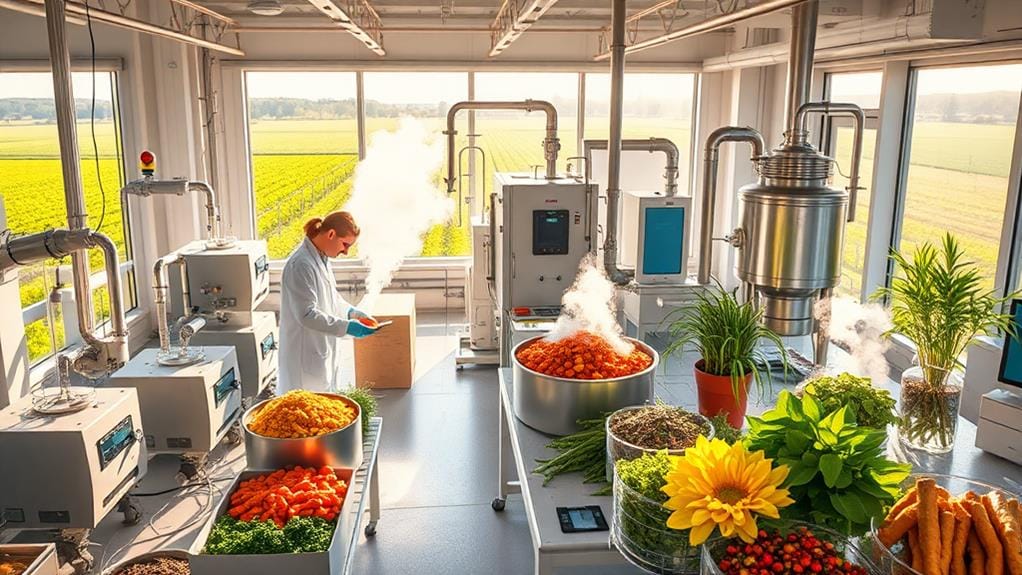
The efficiency of cellulosic ethanol production hinges greatly on innovative pretreatment methods that enhance the accessibility of cellulose in lignocellulosic biomass. Techniques like steam explosion and liquid hot water markedly improve enzyme efficiency for fermentation, enabling us to maximize sugar yields. Weak acid hydrolysis stands out as a favored pretreatment due to its economic and environmental advantages, effectively breaking down lignocellulosic structures while minimizing inhibitory byproducts. Additionally, advances in consolidated bioprocessing allow us to integrate pretreatment and fermentation into a single step, which reduces capital costs and energy consumption. By utilizing mathematical modeling to optimize pretreatment conditions, we can enhance co-fermentation strategies, ultimately improving the overall bioethanol production efficiency from biomass and leading us towards sustainable energy solutions.
Improved Fermentation Processes
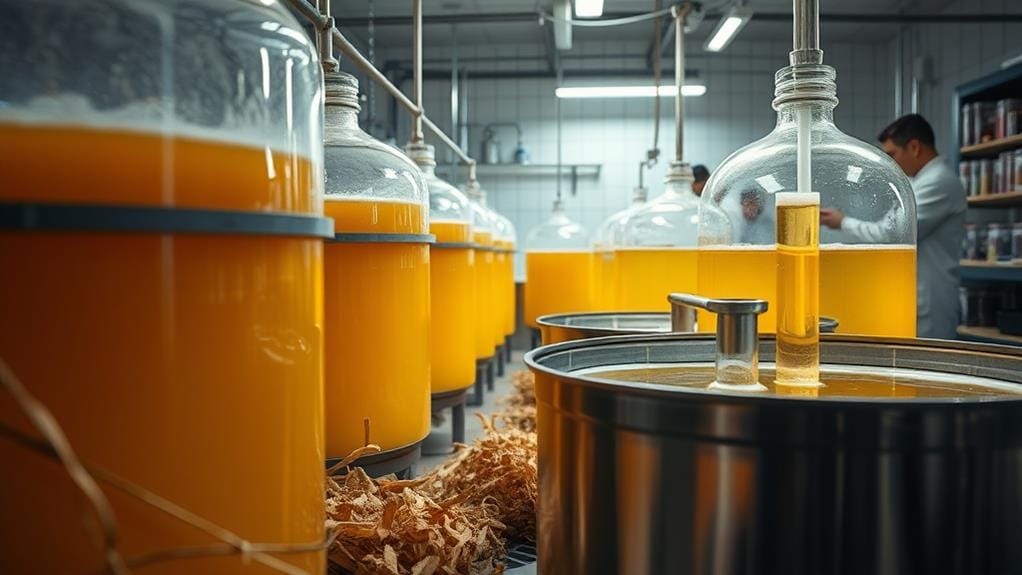
As we explore the domain of improved fermentation processes in cellulosic ethanol production, it is crucial to recognize the pivotal role of enhanced yeast strains and efficient enzyme applications, which have been shown to greatly boost sugar conversion rates. By streamlining process optimization through consolidated bioprocessing, we can achieve greater operational efficiency and lower production costs, thereby advancing the economic viability of biorefineries. Together, these innovations are helping us to maximize ethanol yields while minimizing carbon emissions, marking a major step forward in sustainable biofuel production.
Enhanced Yeast Strains
Enhanced yeast strains represent a significant advancement in the production of cellulosic ethanol, transforming how we approach fermentation processes. These genetically modified organisms, such as Saccharomyces cerevisiae and Pichia stipitis, enhance fermentation efficiency and increase ethanol yield from agricultural waste. Key benefits include:
- Higher tolerance to ethanol and inhibitors found in lignocellulosic hydrolysates.
- Faster fermentation rates, achieving up to 30% improvement over wild-type strains.
- Increased production, with ethanol yields rising by as much as 50%.
Efficient Enzyme Applications
In recent years, efficient enzyme applications have revolutionized the way we approach cellulosic ethanol production. These advances, particularly in immobilized enzymes, have considerably enhanced the conversion of lignocellulosic biomass. By utilizing consolidated bioprocessing techniques, we can combine enzymatic hydrolysis and fermentation in a single step, effectively reducing production costs while improving overall yields. Research indicates that ideal feeding modes, coupled with high sugar concentrations during fermentation, lead to better ethanol yields and lower operational expenses in biorefineries. Furthermore, enzyme cocktails tailored for specific feedstocks, such as corn stover and sugarcane bagasse, maximize the efficiency of both biomass pretreatment and subsequent fermentation processes. Ongoing studies are focused on refining these pretreatment methods to further enhance enzymatic efficiency, critical for achieving cost-competitive cellulosic ethanol production.
Streamlined Process Optimization
Over the past few years, we've seen remarkable advancements in fermentation processes that greatly boost the efficiency of converting lignocellulosic biomass into sugars. These innovations in cellulosic ethanol production signal a transformative shift in fermentation technology, enhancing overall ethanol yield. Key developments include:
- Integration of consolidated bioprocessing for simultaneous enzymatic hydrolysis and fermentation
- Utilization of optimized enzyme cocktails tailored for specific biomass types, maximizing sugar release
- Innovative feeding strategies that enhance fermentation performance and reduce operational expenses
Cost Reduction Strategies
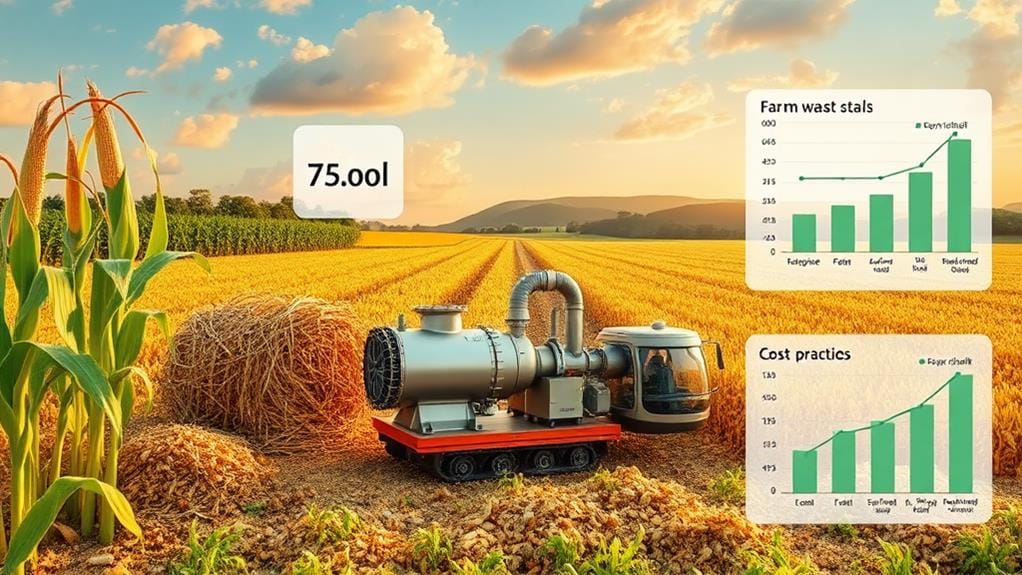
To remain competitive in the energy market, we must prioritize cost reduction strategies for cellulosic ethanol production. By leveraging abundant agricultural residues like corn stover and sugarcane bagasse, we can considerably lower feedstock costs, as these inputs require no additional investments. Additionally, integrating first- and second-generation ethanol production processes through biorefineries allows us to optimize resource utilization, enhancing economic feasibility. Continuous advancements in enzyme technology and pretreatment methods are essential for improving enzymatic efficiency and maximizing sugar yields, further driving down production costs. Life-cycle assessments indicate that coupling bioethanol production with other agricultural byproducts not only supports our cost reduction strategies but also improves investment prospects relative to fossil fuels. Together, we can navigate these complexities and push the industry forward.
Commercial-Scale Production Advances
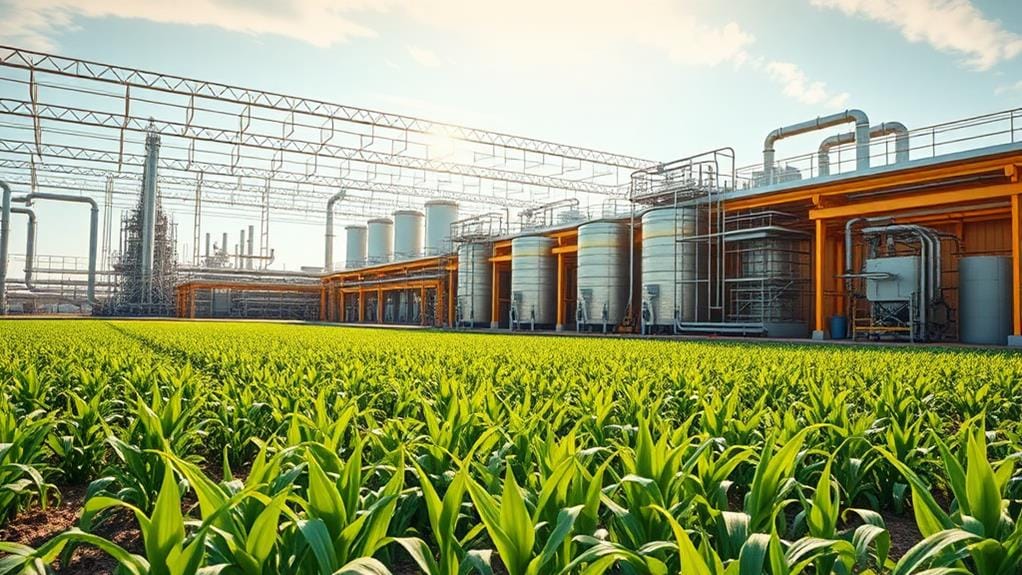
Commercial-scale production of cellulosic ethanol has seen considerable advancements, showcasing the potential for this renewable energy source. The opening of Project LIBERTY in Iowa marked a pivotal moment, as it utilizes corn waste, while INEOS Bios' Indian River BioEnergy Center achieved its first production in 2013 through innovative hybrid gasification and fermentation techniques. Some key points highlight this progress:
- Production costs dropped to $2.15 per gallon by 2012, becoming competitive due to technology advancements.
- Local farmers benefit from utilizing agricultural waste, enhancing the regional economy.
- EcoCeres shipped 850 tons of cellulosic ethanol to Europe, aligning with the EU's Renewable Energy Directive.
These developments contribute considerably to emissions reduction and demonstrate the viability of large-scale cellulosic ethanol production.
Environmental Impact Mitigation
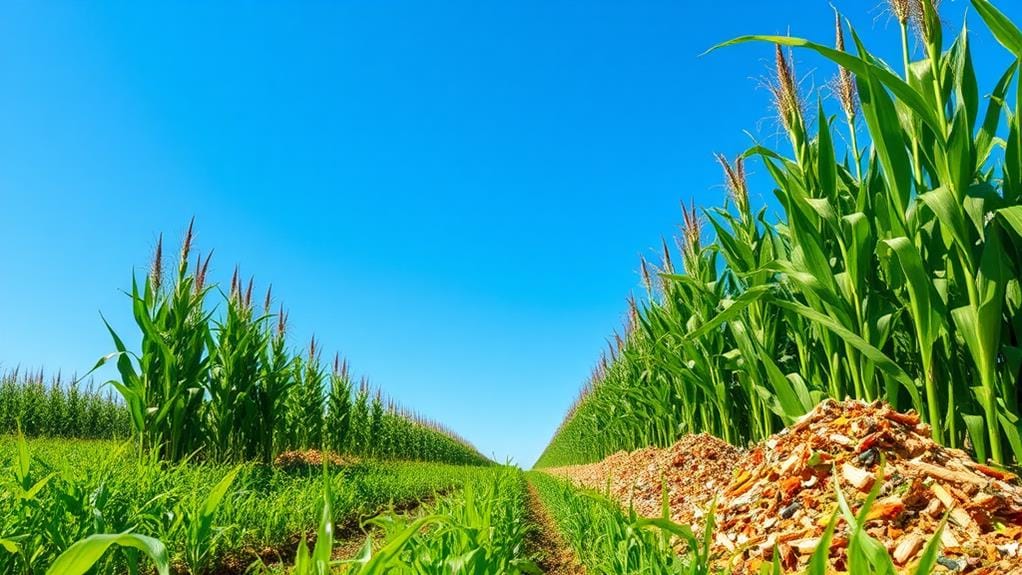
In light of growing environmental concerns, the impact of cellulosic ethanol production on greenhouse gas emissions is promising. By utilizing agricultural waste, such as corn stover and lawn clippings, we can considerably mitigate methane emissions while promoting sustainable waste management practices. Remarkably, cellulosic ethanol can reduce greenhouse gas emissions by over 80% compared to fossil fuels, positioning it as an essential solution for climate change. The carbon intensity of modern production plants can reach as low as 25 g CO2/MJ, which is a striking improvement over traditional methods. Furthermore, life-cycle assessments reveal that lignocellulosic feedstocks contribute to a closed carbon dioxide cycle, enhancing environmental sustainability. Innovations like CO2 capture during fermentation further bolster the positive environmental profile of cellulosic ethanol.
Integration With Existing Infrastructure
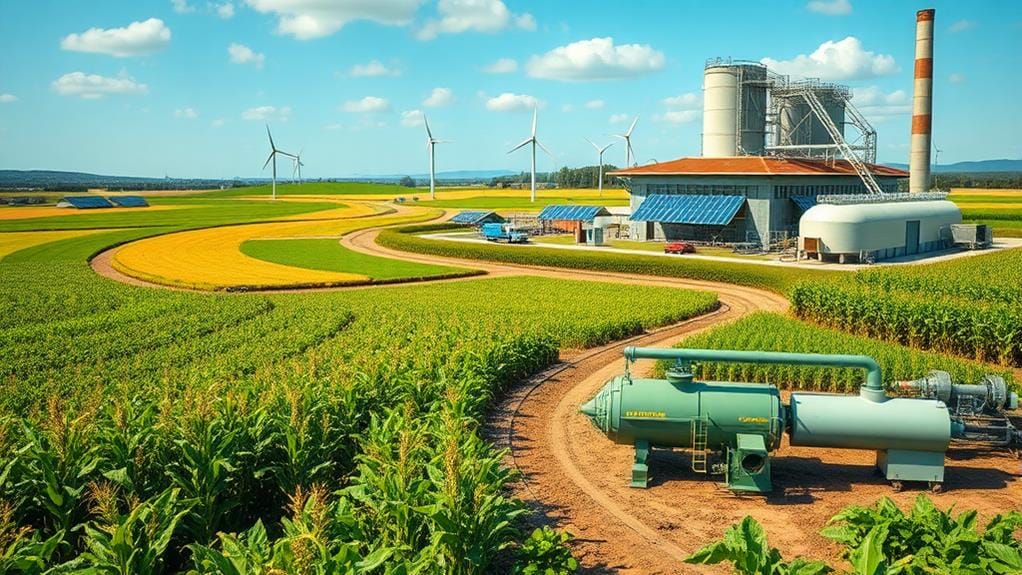
As we consider the integration of cellulosic ethanol with existing infrastructure, it's clear that adapting current biofuel facilities plays an essential role in maximizing efficiency and sustainability. By leveraging established transportation and distribution networks, we can streamline the delivery of biomass feedstocks, while ensuring compliance with regulatory frameworks like the Renewable Identification Number (RIN) system. This strategic approach not only enhances operational viability but also supports the broader goal of shifting to a more sustainable energy future.
Existing Biofuel Facilities Adaptation
With the growing demand for sustainable energy solutions, existing biofuel facilities are evolving to incorporate cellulosic ethanol production. By utilizing agricultural residues such as corn stover and sugarcane bagasse, we can enhance sustainability while reducing operational costs. This adaptation allows us to leverage established processes like fermentation and distillation, minimizing the need for extensive capital investments.
Key factors driving this shift include:
- Efficient use of local biomass, benefiting local economies and supporting farmers.
- Collaborations between traditional biofuel producers and technology innovators to address feedstock handling challenges.
- Evolving regulatory frameworks that incentivize plants adopting advanced biofuel technologies, ultimately lowering carbon emissions.
Together, we're paving the way for a more sustainable energy future through these innovations.
Transportation and Distribution Networks
Adapting existing biofuel facilities to produce cellulosic ethanol is just the beginning; we also need to focus on how this new fuel can be effectively transported and distributed. Integrating cellulosic ethanol into our current infrastructure is crucial for maximizing its market penetration. Current distribution systems can efficiently transport cellulosic ethanol, as it can be blended with gasoline within existing pipelines. This not only optimizes our energy distribution but also aligns with the Renewable Fuel Standard, which supports infrastructure development for higher ethanol blends. To enhance logistics, strategic partnerships between biofuel producers and transportation companies are essential, facilitating the necessary adjustments in infrastructure. Ultimately, significant investments in retrofitting refineries and transport fleets will pave the way for broader adoption, ensuring compliance with evolving sustainability standards.
Regulatory Compliance and Support
Steering through the regulatory landscape is vital for successfully integrating cellulosic ethanol into our existing fuel infrastructure. We must guarantee regulatory compliance with the Renewable Fuel Standard (RFS), which recognizes cellulosic ethanol's lower carbon intensity. This compliance is essential for market acceptance and the long-term viability of our renewable energy initiatives.
Key aspects to evaluate include:
- The Renewable Identification Number (RIN) system for tracking production and usage
- Supportive regulatory frameworks from the Environmental Protection Agency (EPA)
- Incentives stemming from initiatives like the Inflation Reduction Act
Frequently Asked Questions
What Is the Main Problem With Producing Cellulosic Ethanol?
When it rains, it pours for us in cellulosic ethanol production. We're grappling with cost efficiency, feedstock availability, technological advancements, environmental impact, and regulatory hurdles that challenge our journey toward sustainable energy solutions together.
What Is the Major Challenge to Producing Cellulosic Ethanol?
We're all aware that the major challenge to producing cellulosic ethanol lies in improving enzyme efficiency and ensuring feedstock availability. Without technological innovation and strong policy support, economic viability remains a distant goal for us all.
Why Did Cellulosic Ethanol Fail?
We've seen cellulosic ethanol struggle, like a vintage car stuck in traffic. Market viability faltered due to high production costs, inconsistent technology advancements, shifting government policies, and mounting environmental impact concerns that kept investors wary.
How Do You Make Ethanol From Agricultural Waste?
To make ethanol from agricultural waste, we focus on biomass pretreatment, select suitable feedstock, and enhance enzyme efficiency in the fermentation process, all while addressing sustainability concerns together for a greener future.




